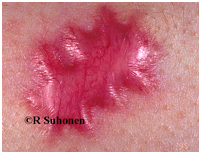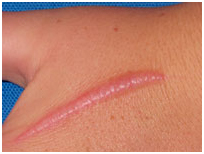Keloids are equally common in women and men. Keloids are less common in children and the elderly. Although people with darker skin are more
likely to develop them, keloids can occur in people of all skin types. In some cases, the tendency to form keloids seems to run in families.
Keloids develop most often on the chest, back, shoulders, and earlobes. They seldom develop on the face,with the exception of the jaw line.
What are keloid scars?
Keloid scars are firm, smooth, hard growths due to spontaneous scar formation. They can arise soon after an injury, or develop months later.
Keloids may be uncomfortable or itchy, and may be much larger than the original wound. Keloids may form on any part of the body, although the
upper chest and shoulders are especially prone to them.
The precise reason that wound healing sometimes leads to keloid formation is under investigation but is not yet clear.
While most people never form keloids, others develop them after minor injuries, burns, insect bites and acne spots. Dark skinned people form
keloids more easily than Caucasians.
Keloids are harmless to general health and do not change into skin cancers.
What are hypertrophic scars?
As wounds heal, scar tissue forms, which at first is often red and somewhat prominent. Over several months, a scar usually becomes flat and pale.
If there is a lot of tension on a healing wound, the healing area is rather thicker than usual. This is known as a hypertrophic scar.
keloid treatments include:
- Moisturizing oils to keep the tissue soft.
- Using pressure or silicone gel pads after injury.
- Freezing the tissue to kill skin cells.
- Laser treatments to reduce scar tissue.
- Radiation to shrink keloids.
Disclaimer
he medical information on this site is only for information and this information is not for diagnostic or treatment purposes result may vari person to person. This information is not substitute for professional diagnosis and treatment.Kindly consult us before making any decisions or for guidance about a specific medical condition. Karam skin, laser and hair transplant is not responsible, and shall have no liability, for any damages, loss, injury, or liability whatsoever suffered as a result of your reliance on the information contained in this site.. The treatment result varies from patient to patient.





